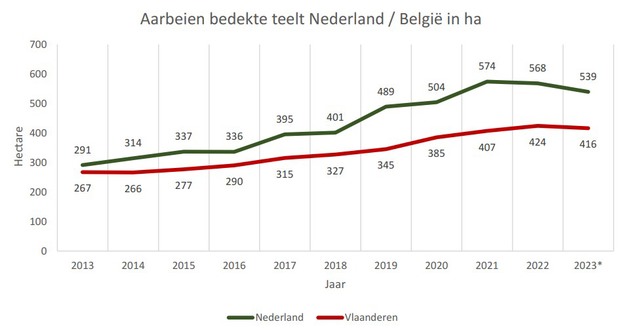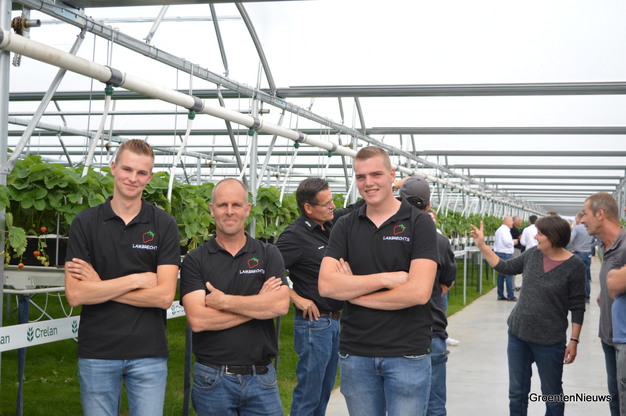The Dutch area of covered strawberry cultivation in greenhouses and permanent tunnel greenhouses has almost doubled in 10 years. A steady increase in acreage can also be seen in Flanders. In recent years, Flemish statisticians consistently point to a shift in cultivation from open-air to covered cultivation. Open-air cultivation yielded 10.2% in 2023, while covered cultivation in greenhouses increased by 9.5%. Dutch open-air cultivation counted 839 hectares for production in 2022. Of the total 1040 hectares in Flanders in 2023, 416 hectares were permanently covered.
-04.jpg?preset=ContentFullSmall)
In recent years, the covered area of strawberry in the Netherlands and Flanders did not really increase. Preliminary figures for 2023 in the Netherlands and Flanders even indicate a slight decrease in the area covered. The energy crisis has also made itself felt in strawberry cultivation, especially among smaller growers, of which strawberry cultivation still has many. Meanwhile, new growers are also getting into cultivation, for example after converting a tomato greenhouse to strawberries. Existing growers also expanded.

Foil or glass?
After tomato, bell pepper and cucumber, strawberry is now a fully-fledged greenhouse crop. Notable are the expansion projects with high-tech glass greenhouses, but for more than one reason this is not always possible. Building a foil greenhouse can then offer a solution. This year, the Belgium Lambrechts family chose to expand with a, also high-tech, foil greenhouse.
A 2.2-hectare foil greenhouse was built on the plot formerly occupied by a tree grower in Beerse. For the strawberry growers, it is not their first greenhouse. Grower Kris Lambrechts, together with wife Tinne Peeters, took over the company from Kris' parents in 2001. Step by step expansion took place, until the latest extension of more than 12 hectares. Kris and his wife, now together with their sons Dries and Stijn, grow in glass and plastic greenhouses as well as on racks.
With the sons in the business, there is ambition for growth. For the most recent expansion, the growers were looking for land nearby. The challenge in Belgium is to find that land and to be allowed to build on it. A glass greenhouse proved unfeasible at the chosen location. The construction of a foil greenhouse, which stays a lot lower, offered a solution. The foil greenhouse, type Ventrio, has a ridge height of 3.40 meters. A lot lower than the most modern glass greenhouses.
The new foil greenhouse contains the variety Elsanta this fall. Next year the intention is to grow a perpetual variety, shares son Dries. More and more strawberry growers are looking at the cultivation of ever-bearing varieties. Delphy trials have already shown how instead of a "sprint," with accompanying labor spike, cultivation becomes a "marathon" with an accompanying flatter, but also longer and more stable production.
Grower Kris with sons Dries and Stijn Lambrechts, running together with mother Tinne and the parents of Kris the family-owned company.
Lights are back on
This winter at the Lambrechts family at a different location, the lights will also go back on for an lit winter crop. In the 2021/2022 season, the growers already gained experience with the lit cultivation. Last winter, the growers skipped lighted cultivation because of the energy crisis, Dries points out, but this winter Coöperatie Hoogstraten, which handles sales, can expect winter strawberries again.
The new construction project in Beerse, although new construction in horticulture is "a bit on hiatus," is not the only project in strawberry country. This year major glasshouse growers Royal Berry and Brookberries also opened new greenhouses, while Dutch Berries is growing through its 40 acres with the recently announced expansion in Zuilichem. Internationally, covered strawberry cultivation is also popular, with several North American growers, for example, moving into strawberry cultivation.
Many of the strawberries grown in the Netherlands and Belgium are for home consumption. Strawberries are exported, but relative to the percentage of Dutch production that remains domestic, this is still limited.
Click here for the photos of the Lambrechts greenhouse.

